Commanders
- Anatoliy Gekker (March 4 - April 6, 1918)
- Pyotr Baranov (since April 7)
- Aleksandr Krusser (since April 20)
The Donetsk Red Army was the field army of the short-lived Donets-Krivoy Rog Soviet Republic during the Russian Civil War. It existed between March 4 and April 15, 1918 and was formed to protect the Republic from the German-Austrian Army, which entered the territory of Ukraine at the invitation of the leadership of the Ukrainian People's Republic. It counted some 8,500 men.
On February 27, the Donets-Krivoy Rog Soviet Republic decided to start the full mobilization of the Republic's military forces by releasing the decree "Revolution in Danger !". The central headquarters of the Red Guards of Donbass in Donetsk were renamed to the headquarters of the Red Army in the Donbass. Soon, the volunteer Donetsk miners and workers were joined by soldiers from the former Russian 8th Army of the Romanian front and Anatoliy Gekker became the commander of the Donetsk Red Army.
On March 16, 1918, the Council of People's Commissars issued a "Decree of hostilities", where it announced "the entry of the Republic into the South Russian military alliance in order to jointly fight against the German occupation". Initially, the Donetsk Army defended the north-Donetsk railway, and from the middle of April it defended the line between the village of Borova, the river Oskol, the river Donets and Yaremche. By the end of the month, it fought in skirmishes against German troops in the region of Lugansk-Rodakovo, together with the 5th Army of the Ukrainian People's Republic under the command of Kliment Voroshilov.

This is a list of historical regions in present-day Ukraine.

Donetsk, formerly known as Aleksandrovka, Yuzivka, Stalin and Stalino, is an industrial city in eastern Ukraine located on the Kalmius River in Donetsk Oblast. The population was estimated at 901,645 in the city core, with over 2 million in the metropolitan area (2011). According to the 2001 census, Donetsk was the fifth-largest city in Ukraine.
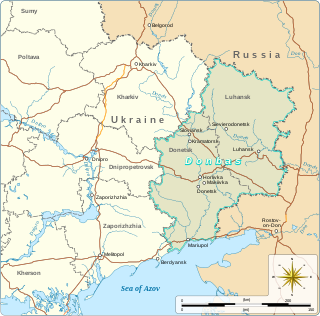
The Donbas or Donbass is a historical, cultural, and economic region in eastern Ukraine. Parts of the Donbas are occupied by Russia as a result of the Russo-Ukrainian War.

The 3rd Guards Army was a field army of the Soviet Red Army that fought on the Eastern Front in World War II.

The Ukrainian Soviet Republic was one of the earlier Soviet Ukrainian quasi-state formations, a pro-Bolshevik Soviet government that resided in Kharkiv.

The flag of the Donetsk Region, often referred to as the flag of Donbas, is the official flag of the Ukrainian region of Donetsk. It was designed by Nina Shcherbak, a Donetsk artist. The flag was officially adopted on 17 August 1999.
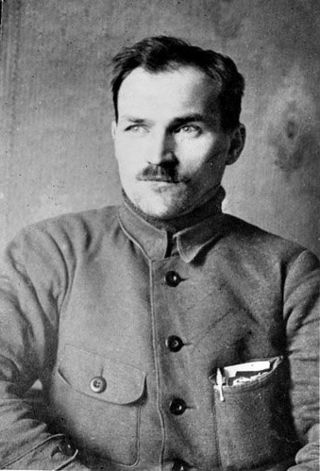
Fyodor Andreyevich Sergeyev, better known as Comrade Artyom, was a Russian Bolshevik revolutionary, Soviet politician, agitator, and journalist. He was a close friend of Sergei Kirov and Joseph Stalin. Sergeyev was an ideologist of the Donetsk–Krivoy Rog Soviet Republic.

The Donetsk–Krivoy Rog Soviet Republic or Donetsk–Kryvyi Rih Soviet Republic was a self-declared Soviet republic of the Russian SFSR proclaimed on 12 February 1918. It was founded three days after the government of the Ukrainian People's Republic (UPR) signed its Treaty of Brest-Litovsk with the Central Powers, which recognised the borders of the UPR. Lenin did not support the creation of the entity and neither did Sverdlov. Some other Bolsheviks like Elena Stasova, however, sent a telegraph of best wishes.

The Ukrainian War of Independence was a series of conflicts involving many adversaries that lasted from 1917 to 1921 and resulted in the establishment and development of a Ukrainian republic, most of which was later absorbed into the Soviet Union as the Ukrainian Soviet Socialist Republic of 1922–1991.

The Don Republic was an independent self-proclaimed anti-Bolshevik republic formed by the Armed Forces of South Russia on the territory of Don Cossacks against another self-proclaimed Don Soviet Republic. The Don Republic existed during the Russian Civil War after the collapse of the Russian Empire from 1918 to 1920.

The Taurida Soviet Socialist Republic was an unsuccessful attempt to establish a Soviet republic situated in the Crimean Peninsula part of Soviet Russia. The republic was established by Bolsheviks Jan Miller and Anton Slutsky who previously participated in the Petrograd Bolshevik Revolution.
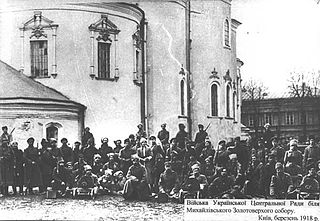
The Ukrainian–Soviet War is the term commonly used in post-Soviet Ukraine for the conflict between Ukrainian nationalist forces and the Bolsheviks from 1917–21. Many Ukrainians view the war as being between the Ukrainian People's Republic, and the Russian Soviet Federative Socialist Republic and Ukrainian Soviet Socialist Republic. The war ensued soon after the October Revolution, when Lenin dispatched Antonov's expeditionary group to Ukraine and Southern Russia.
Donetsk may refer to:
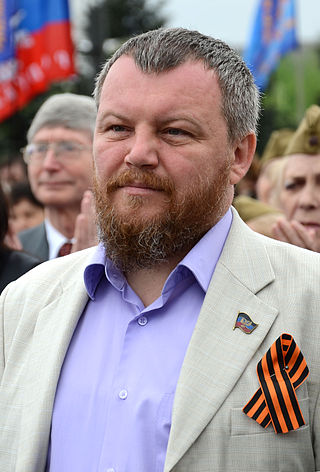
Andrei Yevgenyevich Purgin is a Ukrainian activist, cofounder of the Donetsk Republic organization along with Aleksandr Tsurkan and Oleg Frolov. Until 4 September 2015 he was the Chairman of the People's Council of the (disputed) Donetsk People's Republic.
Donbas separatism is separatist sentiment in the southeast of Ukraine. According to proponents, there is a "common historical, cultural and economic region of Donbas". According to the authors of the concept of the region "is committed to the formation of autonomous and independent states on the territory of Donbas".
The 13th Army was a field army of the Red Army during the Russian Civil War, which existed between 5 March 1919 and 12 November 1920.

Innokentiy Serafimovich Kozhevnikov was an active participant in the Russian Civil War. A member of the Bolshevik Party since 1917, he was one of the organizers of the guerrilla struggle in the rear of the White Army. He became commander of the 13th Red Army. He was imprisoned in 1926 and executed in 1931.

Moisey Lvovich Rukhimovich was a Soviet statesman and politician.

The International Movement of Donbass, or just Intermovement, also called the Interfront of the Donbass was a political movement in the late Ukrainian SSR and the first decade of independent Ukraine. It was founded in 1990 by the members of the intelligentsia in the Donbas region in Eastern Ukraine. It was founded in opposition to the People's Movement of Ukraine, which favored Ukrainian independence from the Soviet Union. Similar Interfront pro-Soviet movements existed in the Latvian SSR, Moldovan SSR and other republics.
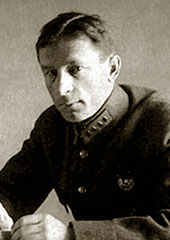
Pyotr Ionovich Baranov was a Soviet military commander and politician who was one of the main creators and organizers of the Air Force and the aircraft industry of the Soviet Union.